Pam Lecky's Blog, page 4
October 15, 2024
Publication Day Interview with Elizabeth St.John
Today in the library, we have a very special guest, fellow historical fiction author, Elizabeth St.John. Today is publication day for her latest book, The King’s Intelligencer. Happy Publication Day, Liz!
A little bit about Liz:Elizabeth St.John’s critically acclaimed historical fiction novels tell the stories of her ancestors: extraordinary women whose intriguing kinship with England’s kings and queens brings an intimately unique perspective to Medieval, Tudor, and Stuart times.

Inspired by family archives and residences from Lydiard Park to the Tower of London, Elizabeth spends much of her time exploring ancestral portraits, diaries, and lost gardens. And encountering the occasional ghost. But that’s another story.
Living between California, England, and the past, Elizabeth is the International Ambassador for The Friends of Lydiard Park, an English charity dedicated to conserving and enhancing this beautiful centuries-old country house and park. As a curator for The Lydiard Archives, she is constantly looking for an undiscovered treasure to inspire her next novel.
Elizabeth’s works include The Lydiard Chronicles, a trilogy set in 17th-century England during the Civil War, and The Godmother’s Secret, which unravels the medieval mystery of the missing princes in the Tower of London. Her latest release, The King’s Intelligencer, follows Franny Apsley’s perilous quest to uncover the truth behind the sudden discovery of the princes’ bones. In Charles II’s court of intrigue and deceit, Franny must decide what she’ll risk—for England’s salvation, her family’s safety, and her own happiness.
Which genre do you write in and what draws you to it?My work is historical fiction, inspired by the people in my family who witnessed some of the most significant times in English history. I have always loved history, and grew up reading books by Jean Plaidy, Anya Seton and Mary Stewart. This sense of connection to the past, through the eyes of those who lived in those times, never fails to enchant me.
Are you an avid reader? Do you prefer books in your own genre or are you happy to explore others?Yes, absolutely. My reading varies, depending on whether I’m writing or researching, or resting (do we ever not think about our writing?!) I do enjoy historical fiction, and especially reading beta drafts or advance copies written by my historical fiction author friends. The time period doesn’t really matter, if it’s well researched and written. When I’m writing, I tend to read way outside of my genre – perhaps a beach romance or a crime thriller for escapism – and lots and lots of non-fiction to support my current story.
Are you a self-published/traditional or hybrid author?All my books are independently published, and I think always will be. I have such an intensely personal relationship with all of them that it would be really difficult to give editorial and creative control to a third party. Besides, I do love the freedom to follow my own instincts on the story, and working in partnership with my editor and cover designer.
Has your country of origin/culture influenced your writing?
Yes, tremendously. I chose (or they chose me) to write about my ancestors, and so they are the lynchpin of my novels. They also happened to live in some really interesting and beautiful places in England – The Tower of London, Lydiard Park, Bolton Castle – and so it’s been a pleasure to visit these historic sites, walk in their footsteps, and enjoy meeting them in person through their portraits, letters, diaries and other papers. I’m also fortunate that I have a well-documented family tree inhabited by some fascinating people, so I’m not leaving any time soon!

What was the best piece of writing advice you received when starting out?
“Write what you love.” I think it’s so important to feel a passion for your subject, your characters, your plot. The reader senses if you’re not fully engaged. The times I’ve struggled with my writing is when I’ve strayed from that, trying to write what I think people might want to read, and when I’ve put that to one side, it flows again. So, by writing about what I love, I hope I can support it with great research and unique story-telling.
If a movie was made of one of your books, who would you like to play the lead roles?Oh I play this game with my other historical fiction author friends – we have a small group that sends each other photos and memes of our “hot pick” just to keep us going when we’re in the doldrums of first drafts. I’ve always opted for Henry Cavill…the only challenge is that my characters age faster than he does. On the bright side, he fits every male lead that I’ve written…so Henry, if you’re reading this, call me!
Please tell us about your latest published work.
The King’s Intelligencer
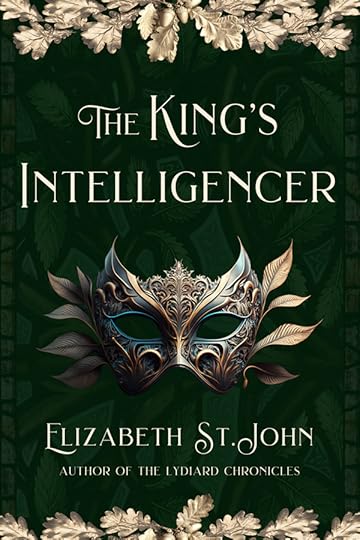
The Discovery of the Princes in the Tower
London, 1674: When children’s bones are unexpectedly unearthed in the Tower of London, England’s most haunting mystery—the fate of the missing princes—is reignited.
Franny Apsley, confidante to Lady Mary Stuart, heir to King Charles’s throne, becomes embroiled in the royal court’s excitement over the discovery of children’s bones. Could they be the missing princes? As a devastating family secret emerges, Franny is recruited by her cousin Nan Wilmot to determine the truth behind the bones. Her investigation, complicated by an attraction to the secretive court artist Nicholas Jameson and the influence of an enigmatic royal spy, reveals a startling plot threatening the throne and England’s stability.
In a glittering and debauched society where love is treacherous and loyalty masked, Franny must navigate a world where a woman’s voice is often silenced and confront the ultimate question: What is she willing to risk for the sake of her country, her happiness, and her family’s safety?
A captivating historical novel of conspiracy, passion, and courage, The King’s Intelligencer is one woman’s quest for a truth that could change the fate of a nation. A companion to the critically acclaimed best-selling novels The Godmother’s Secret and The Lydiard Chronicles, The King’s Intelligencer weaves beloved characters and actual events together to bring a suspenseful mystery to life
Available on #KindleUnlimited
Universal Buy Link: https://geni.us/KingsIntelligencer
Website: https://www.elizabethjstjohn.com/
Twitter: https://x.com/ElizStJohn
Facebook: https://www.facebook.com/ElizabethJStJohn/
LinkedIn: https://www.linkedin.com/in/elizabethjstjohn/
Instagram: https://www.instagram.com/elizabethjstjohn/
Threads: https://www.threads.net/@elizabethjstjohn
Bluesky: https://bsky.app/profile/elizabethstjohn.bsky.social
Book Bub: https://www.bookbub.com/profile/elizabeth-st-john
Amazon Author Page: https://geni.us/AmazonElizabethStJohn
Goodreads: https://geni.us/GoodreadsElizStJohn
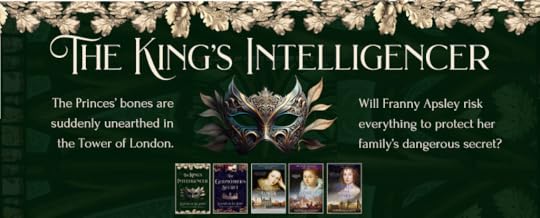
October 4, 2024
Book Spotlight: The Pirate’s Physician by Amy Maroney
Today, I am delighted to take part in the book spotlight blog tour for Amy Maroney’s newest release, The Pirate’s Physician, which was published in September.
You can follow the full tour here: https://thecoffeepotbookclub.blogspot.com/2024/08/blog-tour-the-pirates-physician-by-amy-maroney.html
The Pirate’s Physician: A Thrilling Companion Novella to the Sea and Stone Chronicles by Amy Maroney
When her world shatters, she dares to trust a pirate. Will she survive what comes next?
The Pirate’s Physician is the story of Giuliana Rinaldi, a student at Salerno’s famed medieval medical school, whose lifelong dream of becoming a physician crumbles when her uncle and mentor dies suddenly.
Faced with an unwanted marriage to a ruthless merchant, Giuliana enlists the help of a Basque pirate and flees home for the dangers of the open sea.
Will she make it to Genoa, where her only remaining relative awaits? Or will this impulsive decision seal her own doom?
A delightful seafaring adventure packed with romance and intrigue, The Pirate’s Physician is a companion novella to the award-winning Sea and Stone Chronicles series of historical novels by Amy Maroney: Island of Gold, Sea of Shadows, and The Queen’s Scribe.
Buy Link:
Universal Buy Link: https://mybook.to/PiratesPhysician
Author Bio:
Amy Maroney lives in the Pacific Northwest with her family, and spent many years as a writer and editor of nonfiction before turning her hand to historical fiction.

Amy is the author of the Miramonde Series, a trilogy about a Renaissance-era female artist and the modern-day scholar on her trail. Amy’s new series, Sea and Stone Chronicles, features strong, talented women seeking their fortunes in the medieval Mediterranean.
To receive a free prequel novella to the Miramonde Series, join Amy Maroney’s readers’ group at http://www.amymaroney.com.
Author Links:
Website: https://www.amymaroney.com/
Twitter: https://x.com/wilaroney
Facebook: https://www.facebook.com/amymaroneyauthor/
Instagram: https://www.instagram.com/amymaroneywrites/
Pinterest: https://www.pinterest.com/amyloveshistory/
BookBub: https://www.bookbub.com/authors/amy-maroney
Amazon Author Page: https://www.amazon.com/stores/Amy-Maroney/author/B01LYHPXEO
Goodreads: https://www.goodreads.com/author/show/15831603.Amy_Maroney
October 2, 2024
Operation Tulip by Deborah Swift: The Coffee Pot Book Club Blog Tour
Today, I am delighted to welcome Deborah Swift back to my blog for the book blog tour for Operation Tulip, her new release. This book is part of her Secret Agent Series (WW2). Deborah has kindly included an excerpt from the book (see below).
You can follow the full tour here:
https://thecoffeepotbookclub.blogspot.com/2024/07/blog-tour-operation-tulip-by-deborah-swift.html
Operation Tulip by Deborah SwiftHolland, 1944: Undercover British agent Nancy Callaghan has been given her toughest case yet. A key member of the Dutch resistance has been captured, and Nancy must play the role of a wealthy Nazi to win over a notorious SS officer, Detlef Keller, and gain crucial information.
England: Coding expert Tom Lockwood is devastated that the Allies have failed to push back the Nazis, leaving Northern Holland completely cut off from the rest of Europe, and him from his beloved Nancy. Desperate to rescue the love of his life, Tom devises Operation Tulip, a plan to bring Nancy home.
But as Nancy infiltrates the Dutch SS, she finds herself catching the eye of an even more senior member of the Party. Is Nancy in too deep, or can Tom reach her before she gets caught?
Inspired by the true events of occupied Holland during WW2, don’t miss this utterly gripping story of love, bravery and sacrifice.

Praise for Deborah Swift:
‘A well crafted tale… this book did not disappoint’ NetGalley reviewer, 




‘There is action, mystery and romantic entanglements stirred into the story for a fantastically entertaining read’ NetGalley reviewer, 




Universal Buy Link: http://mybook.to/Tulip
Operation Tulip: ExcerptBaker Street, London
Tom Lockwood put the newspaper down on his desk, took off his glasses to rub his eyes, then put his head in his hands. So the rumours were true. Operation Market Garden had failed. Monty’s tanks had got stuck in mud and instead of a liberated Holland, they were now faced with half a country cut off completely from foreign aid. What would Gerbrandy, the Dutch Prime Minister do now?
Tom chewed his pencil. No-one could possibly understand just how desperately he’d been looking forward to Nancy coming home, and to the end of this whole damn war. A few weeks ago he could almost touch it.
And what would liberating only half of Holland mean for his job here at Baker Street? Would N Section be training any more men? He enjoyed his work – there was something satisfying in bashing the mysteries of codes and ciphers into the brains of new agents.
Just then his telephone rang.
Neil’s familiar voice down the crackly line. ‘Have you heard anything?’ He meant about Nancy of course, though he couldn’t say it. Neil was Nancy’s brother and they were both supposed to think Nancy was working as a nurse with the First Aid Nursing Yeomanry, or FANYs. They weren’t supposed to know she was an agent in occupied Holland.
‘No, nothing,’ Tom replied. ‘Just what I read in the paper.’
‘Lilli and I listened to Radio Oranje last night like I always do. It’s horrendous. The port of Rotterdam is in ruins and the Germans are destroying anything the Dutch have built, out of sheer spite. Generations of trade reduced to rubble! Not just that, but can you believe they’re bombing and destroying pumping stations? At this rate coastal areas will soon be back under water. They’re evacuating the coastal towns but there’s no way people can get out of the occupied zone, they’ve just nowhere to go.’ His voice cracked. ‘Most of them are too scared to do anything but hide.’
Tom flipped the paper over, one ear glued to the phone. ‘I’ve got the Standard in front of me and it says here they’ve no electricity or fuel. No trams, no telephones. We have to do something. I can’t bear to think of how bad it must be.’
‘What? We can’t do anything.’
‘I don’t know.’ He lowered his voice, ‘Get Nancy out somehow.’
‘But how can we do that? I’m still here at the radio unit at Wavendon, and you can’t do anything with Beauclerk. You know how he has to okay every last little thing.’
Tom pictured his boss, worn ragged by the war. Beauclerk was a nervous wreck, but he’d some sympathy for the man. Though still heading the offices at Baker Street, he was obviously unwell, grey in the face and showing signs of Parkinson’s disease. ‘I don’t know. Can you and Lilli get up to London?’ Lilli was Neil’s wife.
‘Maybe, next weekend, if we can get a train.’
‘Come to my flat then, and in the meantime, I’ll see what I can find out.’
*
Tom loped up the long flight of stairs to the offices and knocked on Beauclerk’s door. A grunt of ‘Enter’ from his boss. Beauclerk was leaning on the desk, poring over the same latest edition of the Evening Standard, a cold cup of coffee at his elbow. The picture of the King on the wall behind him had been replaced with one of Churchill, complete with brooding, intent expression, and cigar in hand.
In contrast, the war hadn’t treated Beauclerk well, his face was drooping, worn and greyish, like old lined concrete.
A sigh. ‘What is it now?’ Beauclerk’s voice had a resigned tone. He clutched one arm to his waistcoat to stop it shaking. His Parkinson’s disease must be getting worse.
‘I saw the papers. What are ‘N’ Section doing about the agents in the north?’ Tom asked. ‘Are they being evacuated?’
A sigh. ‘You know perfectly well I can’t tell you that.’
‘Which means they aren’t.’
‘Their intelligence is still useful. And the place will fall eventually. Has to.’
‘Eventually. When they’re all dead of starvation. You’ve read it?’ Tom pointed to the Standard.
‘Look, I can’t do anything. I know it’s bloody, but I can’t. I should throw you out of my office with a flea in your ear for even asking.’
‘You won’t though. Because you know I’m one of the few people you can trust. That you can tell the truth to. And that counts for a lot in this mad old game we’re in.’
Beauclerk made a face and stirred his cold coffee. Tom watched the milky skin congeal around the spoon.
‘It’s plain enough we can’t get troops over the Maas river,’ Beauclerk said. ‘The Germans have bedded in. The coastal ports are sealed. No-one can get in or out. We’ve stopped all agent drops. Anti-aircraft guns line the banks of every estuary and canal, so there’s no way we can fly anyone in or out.’
‘So our agents’ll just be left to rot with no supplies, no ammunition, and no possible way out.’
‘I’m sorry Tom, but I can’t do anything. And I suppose now’s as good a time as any to tell you – I’m retiring.’ He shrugged. ‘I’m an old horse and they’re putting me out to grass. Ill-health.’
‘When?’ Tom reeled. Baker Street ‘N’ Section without Beauclerk was unthinkable.
‘End of next week. Last of the month. It’ll be Paterson’s problem then, not mine.’
‘Paterson? Rodney Paterson?’ Tom couldn’t believe it. ‘But he’s hopeless. He’s just a jumped-up yes man!’
‘Whatever you think of him, he’s my replacement. He’s tasked with winding down my section of the Political Warfare Executive. And you know him, he always likes to do things by the book.’
Tom groaned. ‘Everything he does is glacial. It’s a catastrophe over there! Someone will have to do something – not just for our agents, but the whole of Holland.’
Author Bio:Deborah Swift is a USA TODAY bestselling author of twenty books who is passionate about the past. Deborah used to be a costume designer for the BBC, before becoming a writer. Now she lives in an old English school house in a village full of 17th Century houses, near the glorious Lake District. After taking a Masters Degree in Creative Writing, she enjoys mentoring aspiring novelists and has an award-winning historical fiction blog at her website www.deborahswift.com.

Deborah loves to write about how extraordinary events in history have transformed the lives of ordinary people, and how the events of the past can live on in her books and still resonate today.
Recent books include The Poison Keeper, about the Renaissance poisoner Giulia Tofana, which was a winner of the Wishing Shelf Book of the Decade Award, and a Coffee Pot Book Club Gold Medal. Her most recent books are The Silk Code and The Shadow Network both set in the Second World War.

Author Links:
Twitter https://twitter.com/swiftstory
Facebook: https://www.facebook.com/authordeborahswift/
Website www.deborahswift.com
Pinterest https://www.pinterest.co.uk/deborahswift1/
September 24, 2024
Book Spotlight: Penny Hampson and A Winter’s Romance Anthology
Today, I am delighted to host fellow historical fiction author, Penny Hampson, on my blog. Penny writes the Gentlemen Regency series. If you are a Georgette Heyer fan, you’ll really enjoy Penny’s stories. Penny is one of six authors whose new anthology, A Winter’s Romance, will be published on 4th November 2024. And it sounds like the perfect curl-up-beside-the-fire read! (Pre-order link below)
A Winter’s Romance is an anthology of short stories by six different romance writers. All the stories are set during the Regency, so if you enjoy novels by Julia Quinn (Bridgerton), Georgette Heyer, or Jane Austen, you might enjoy finding out what other modern authors have to say about this period.
The theme is winter. Now this can conjure up happy scenes of Christmas celebrations, snow-filled landscapes, feasting and general merriment; it can also be a time of sadness. My story, ‘A Christmas Wish’, blends a few elements of both.

My heroine, Jane Mortimer is not looking forward to Christmas. She is a teacher at a school in Bath, with no family and no finances. At the mercy of the headmistress, who wants her to lie about conditions at the school in order to secure funds, Jane is conflicted. If she lies she will keep her job, but if she tells the truth she will lose her position and become homeless.
The test will come with the arrival of her favourite pupil’s new guardian, Lt Colonel Nicholas Anstruther, the man she is expected to lie to.
Nicholas has a few problems of his own. As a single man, he doesn’t want the care of a child he has never met. He’s unlikely to marry, for who wants a badly scarred soldier with only one good eye? The only life he’s known is the army.
In fact, the only person optimistic about his visit is Meg, Nicholas’ ward and Jane’s favourite pupil.
How will things work out? Well, Christmas is coming and Meg believes that wishes made then will come true.
A Winter’s Romance is a Regency romance anthology perfect for curing the wintertime blues. GL Robinson, Audrey Harrison, Penny Hampson, Judith Hale Everett, Christina Dudley, and Jayne Davis have collaborated to bring you six delightful short stories. Pre-order it now!
Buy Link: https://MyBook.to/WinterRomance
Author Bio: Penny Hampson
Penny HampsonPenny Hampson writes mysteries, and because she has a passion for history, you’ll find her stories also reflect that. A Gentleman’s Promise, a traditional Regency romance, was Penny’s debut novel and the first of her Gentlemen Series. There are now three novels in the series, with the fourth, An Adventurer’s Contract, due to be released by the end of 2024.
Penny lives with her family in Oxfordshire, and when she is not writing, she enjoys reading, walking, swimming, and the odd gin and tonic (not all at the same time).

Twitter: https://twitter.com/penny_hampson
Facebook: www.facebook.com/pennyhampsonauthor
Instagram: @pennyhampsonauthor/
Penny’s books are all available on Amazon: viewauthor.at/Pennysbooks
September 19, 2024
Ships of War – Murky Waters by Bradley John: The Coffee Pot Book Club Blog Tour
Today, I am delighted to host Bradley John for the blog tour for his new release, Ships of War – Murky Waters, part of the Ships of War Series. Bradley has kindly provided an excerpt – please see below.
You can follow the full tour here:
Tour Schedule Page: https://thecoffeepotbookclub.blogspot.com/2024/06/blog-tour-ships-of-war-murky-waters-by-bradley-john.html
Ships of War — Murky Waters, by Bradley John1791 — England’s cannon remain ever silent as her shipping is ruthlessly preyed upon, a detestable state of affairs, though soon to be remedied…
England is ill prepared, Europe is in turmoil and the French Revolution is readying to sweep across the continent. A tedious uneasy peace poises on a knife’s edge. Brittana rules the waves, yet as more and more ships mysteriously vanish, it is rightly thought an act of war. However, England needs more time, or all could be lost.
With war looming, Lieutenant Hayden Reginald Cooper, Royal Navy, waits in Portsmouth braving a bitter cold winter with half pay, beached in a constant state of penury. With little prospects, little “interest” and no chance of promotion or advancement, he is the perfect choice for the Admiralty: unknown, unimportant and wholly dispensable.
As so it begins, a turbulent action-packed naval adventure within the murky waters preceding war, the French piracy soon to discover the grit of a lowly Lieutenant, one who has very little to lose…

Buy Link:
Universal Buy Link: https://books2read.com/u/br2gDZ
Ships of War — Murky Waters (excerpt)Holt beheld the incoming broadside standing tall upon the quarterdeck. In the first moments he regarded the undeniable sight of smoke instantly puffing from the ships yonder, silently though, for the sound had not yet fully travelled. He was thereafter borne of a singular mind, assuredly a mind to which all familiarity with the outside world now fell lost. It certified within him a suffering never before deemed imaginable. It was a hostility he would soon not forget, such was his boyhood innocence. Noted instantly were a great many astonishing sounds, all racing to rupture the virtue of his lobes, an overall resonance seemingly strange and without a doubt wholly outlandish. Having never been on the receiving end of such a broadside, it openly gave him pause. The whistling tunes aloft seared the sky and oh how they chanced to inflict the gravest of thoughts, the wind of the enemy’s shots whizzing as they trespassed upon the ship. The scene descended upon him most abruptly, the horrendous tearing of sails overhead, the ripping of canvas crying aloud as the weight of spars sought to claw them down. Splinters upon bulwark and gunwale haphazardly flew, mimicking a violent winter’s storm, more furious than even a hundred wood choppers madly serving their axes. All about the planking, indeed immersed within the depths of the structure, Agamemnon shuddered and trembled, the penance of each shot hurried from the ship. The roaring of cannon reverberated within his chest, almost as if he were in fact somehow the barrel itself, the hum of each shot grabbing wickedly at his heart. The deafening turmoil within sought to impose a hideous most disturbed feeling and immediately he felt inclined to be uncontrollably ill, the vile gurgling about his abdomen finally seeping the sanctity of his throat.
Author Bio:
Bradley John Tatnell (aka “Bradley John”) is an Australian novelist whose ancestry can be traced back to the Norman Conquest in England. His forbears lived mostly in Kent, Hertfordshire and the Isle of Thanet. Some were mariners and some were even of the aristocracy. His direct ancestors arrived in Australia soon after its colonisation in the late 1700’s, most of which were proud country folk. James Squire, a notable character in history, who arrived on the first fleet in 1788, was his (sixth) great grandfather.
Bradley John graduated from the Church of England Grammar School at age 16 and the Queensland University of Technology at age 19. His early life was spent mainly in the arena of law.
Bradley John has a love of all things ancient and historical, including golf, to which he plays with ye old hickory shafted clubs including the original heads from pre-1935. He also studies the ancient art of Korean sword, having attained master level. His love of language, in all its forms, now extends to the pursuit of conquering Hangul, the language of the Korean people.
Bradley John has been privately writing novels since 2003. “Ships of War — Murky Waters”, his first publication, births a series of naval adventure fiction intended to span the length of the French Revolutionary Wars. This of course is the much loved genre which includes the thundering Hornblower series by C.S. Forester, the Aubrey-Maturin series by Patrick O’Brian and the popular “Master and Commander” blockbuster by Peter Weir. Owing to Bradley John’s English heritage, no guesses are needed to determine which side the book’s heroes will sail upon…
Author Links:
Website: https://www.bradleyjohnauthor.com
Facebook: https://www.facebook.com/people/Bradley-John-Author/61555706665586
September 18, 2024
Lucy Goes Forth!
I am delighted to announce that today is publication day for A Pocketful of Diamonds, Book 4 in the Lucy Lawrence Mystery Series.
A missing count, stolen diamonds, a mystery that needs solving on the glamorous shores of Lake Como…
I’m often asked about the inspiration for my books. For the fourth book in the Lucy Lawrence series, that is very easy to answer: the location. My first visit to Lake Como, Italy, was back in 2008 as part of a holiday in the area. I fell in love with the location instantly, so much so, in fact, I have been back there for holidays several times now. However, back in 2008, I wasn’t writing books, but the magnificent scenery and ambiance stayed with me.
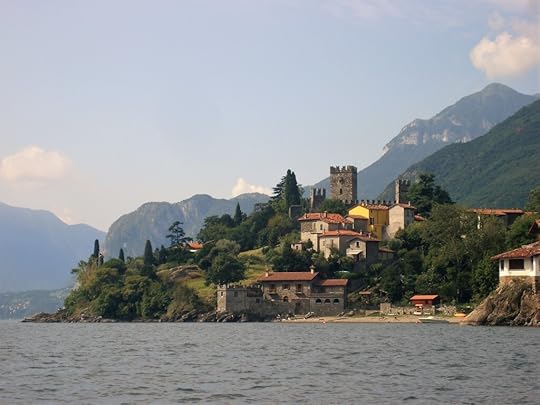 Lake Como, 2008
Lake Como, 2008Lucy has had many adventures since No Stone Unturned, the first book in the series, and it is fun to use different locations for the books. This was even more important for the second book, Footprints in the Sand, which was set in Victorian Egypt, helping to satisfy my love and interest in Ancient Egypt and Victorian era tourism. For the third book, The Art of Deception, Lucy gets to visit Edinburgh, another favourite place of mine. But when it came to a location for A Pocketful of Diamonds, I knew it had to be Italy and it had to be Como.

Way back when only the wealthy travelled for pleasure, Italy was a must-go-to for The Grand Tour. With the industrial revolution came wealth, the railways and the birth of mass tourism. The Victorians loved travel and in the latter part of the 19th century, Lake Como and all the Italian lakes were particular favourites. September was the most popular time, when the intense heat had subsided. The rich Milanese owned villas on the lake with private jetties snaking out into the water. Those villas still stand and were part of the inspiration for the story.
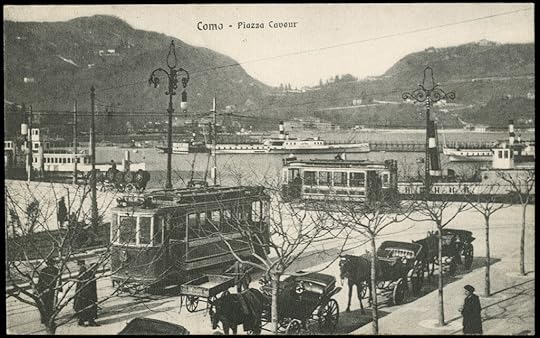
But for me, it was the sorry sight of a derelict hotel, Hotel Grande Bretagne, which stuck with me and as I began to plot the story, I knew I had to include it. In the story, the hotel is called Grand Hotel Bellagio, and is owned by Lucy’s brother-in-law who has disappeared without trace, just weeks after the theft of diamonds from a wealthy guest.
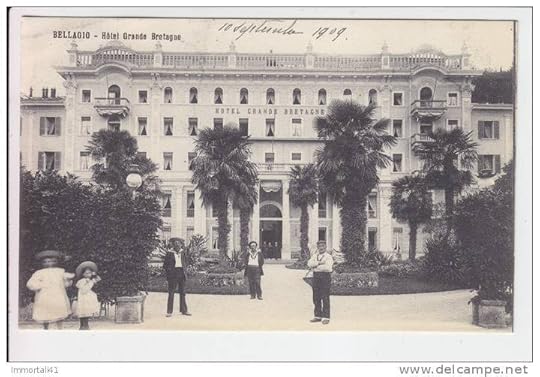 Photo credidt: http://www.delcampe.net
Photo credidt: http://www.delcampe.netIn its heyday, Hotel Grande Bretagne, was a luxurious hotel catering to rich travellers. Located on the outskirts of Bellagio, it must have been quite a sight back then. It is sad to see the state of the hotel now. During one visit, it looked as though it was being restored, but when I was back there in 2021, work had ceased.
 Hotel Grande Bretagne 2018
Hotel Grande Bretagne 2018Then, to my delight, I discovered that smuggling had been a huge problem in the area right up to WW2, with some locals travelling across the border at night, in treacherous conditions, and bringing back goods such as salt and tobacco which they could sell at a higher price. I couldn’t resist and had to include those activities as a sub-plot.
For those who have read the series so far, you know that Lucy invariably gets herself into scrapes and it is often Phineas who must come to the rescue. Dear readers, you hardly thought that Lucy and Phin would have a non-eventful honeymoon, now did you?
So, in the vein of my favourite author, Dorothy L Sayers, our heroes have a busman’s honeymoon!
 Books 1-4: The Lucy Lawrence Mystery Series
Books 1-4: The Lucy Lawrence Mystery SeriesBuy Links:
No Stone Unturned: https://geni.us/715-al-aut-am
Footprints in the Sand: https://geni.us/717-al-aut-am
The Art of Deception: https://geni.us/719-al-aut-am
A Pocketful of Diamonds: https://geni.us/721-al-aut-am
September 12, 2024
Guest Post: Nancy Jardine
Today, I am delighted to have Nancy on my blog. An historical fiction author with many wonderful books to her name, Nancy kindly gives us some insight into the world of her main character, Margaret, in her newest release, Novice Threads.
Sharing is CaringThe phrase pops up on internet sites quite regularly but that’s not what my main character finds in Scotland during the 1840s when she is growing up…
Margaret Law, main character in Novice Threads (Book 1 of The Silver Sampler Series) loves words but she’d be confused by the above phrase. She spends hours wanting to know what everything means but at the tender age of five she’s stumped by things people around her say that don’t make sense. This is especially true when learning Victorian hymns, her parents being extremely devout churchgoers who drag her to services twice-on-a-Sunday with afternoon bible readings in between. However, Margaret instinctively knows that education is the key to a better future and that knowledge is essential.
A huge hurdle for Margaret is that few working-class girls are educated beyond a basic knowledge of reading and writing, and she craves so much more! Well before the 1840s, parishes in Scotland had to provide a schoolroom but that didn’t mean schooling was compulsory, or free. In general, sons were sent to the local school to learn to read, write and count, though some went well-beyond the basics so long as the quarterly fees for the dominie (schoolmaster) were paid. If educated at all, girls tended to go to a cheaper ‘Dame’ School, a facility that might teach basic reading skills but was designed to instruct girls in the arts of cooking, sewing, and how to housekeep. This was regarded as all girls required before they married and had their own home, or went into service in a larger domestic setting.
Little Margaret doesn’t know why she’s unlovable but she senses her parents have no real love to give her. William and Peggy run a local drapery shop in the rural mill-town of Milnathort. They’re not the poorest, yet money to spare is rare. Margaret is well-fed, well-clothed and with decent boots on her feet – unlike Margaret’s best friend Jessie who is the illegitimate daughter of a mill-worker. Yet, even at the age of five, Margaret knows she’d rather have the hugs and overt love that Jessie gets from her mother and grandmother, none of that ever coming Margaret’s way from her cold parents.
Margaret’s totally overjoyed when her father insists on paying for her to attend the local Subscription School. Peggy is against spending the money, claiming she can teach Margaret all she needs to know. William wins that particular argument, one of many acrimonious shouting-matches that Margaret has to listen to over the years. Declaring that since he has no son (and will never have one) Margaret must learn to read the Sunday afternoon bible readings.
Margaret is a little sponge soaking up knowledge as the years pass. She aspires to become a fully-fledged teacher though, in 1850, few women worked as certificated teachers in Scottish schools.
Everybody around Margaret knows how much Queen Victoria and Prince Albert love each other and they adore their large brood of children, but Margaret’s home situation seems entirely the opposite. William rarely shares anything with Margaret at all except for his religious views, and her mother isn’t much different. Her parents embrace new religious sects in pursuit of the ‘best doctrine’ for them, but Margaret is later to find that all is not as is seen on the surface with regard to her parents!
If he shared details of Queen Victoria, William might tell the curious young Margaret that Victoria was fifth-in-line for the monarchy when she was born in 1819. He might say that Victoria’s father, her grandfather, and two of her uncles would all have to die before she’d become queen. Margaret would be sad to learn that Victoria’s father died in 1820 from pneumonia, the well-known and brutal silent killer, before Victoria was a year old. However, William Law wouldn’t share particulars about Victoria’s grandfather being ‘the mad king’ who died almost immediately after her father. And explaining about the profligate and licentious Regency period from 1811 to 1820 would have been beyond the pale.

William Law wouldn’t be telling Margaret about King George IV’s mistresses, or about the monarch’s excessively lavish lifestyle. Those scurrilous ‘facts’ were definitely popular in some daily or weekly newssheets, but not in the ones William subscribes to.
And the next king, William IV? Nothing would be divulged about William’s illegitimate son by an unacknowledged mother, nor about King William’s long-term mistress, the ex-actress ‘Mrs Jordan’, who bore him ten children. Margaret might learn that King William eventually married at the age of 53 but had no surviving legitimate children, which was why Victoria became queen in 1837. Facts, yes, but never salacious ones.
Devastatingly, Margaret has to leave school before her twelfth birthday, circumstances forcing her parents to give up their drapery business. However, the job she gets as a tutor in Edinburgh, in a household where her friend Jessie works, is an incredibly good alternative to becoming a teacher. When her employer organises the use of a local lending library, Margaret learns far more about the monarchy and Victorian morality when she is exposed to some of those famous politically inspired ‘Punch’ cartoons in the weekly periodical which was started up in 1841, a cartoon style which imitated the earlier sketches from the late 1700s. Though Margaret could never take anything like a copy of Punch back to the Duncan house to devour during her own time, nor could she share such literature with her young pupil.
Unfortunately, Margaret gradually learns that the veneer of Victorian morality can be a sham. Her employers, the Duncans, hide many secrets, shames, and volatile situations – different to, but just as explosive as things her parents hide from her over the years. Growing up for young Margaret brings incredible joys but also terrible heartaches as she matures in a somewhat morally confusing Victorian society.

Buy Link: https://Mybook.to/NTsss
Author Bio: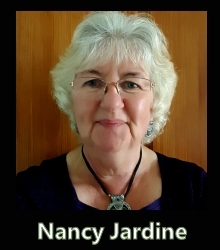
If I’m not found staring into space beyond my desk (though some may call it my ‘thinking about/doing’ writing time) then the remainder of my week tends to be spent working in my garden, which always needs attention, or passing the time of day with my grandchildren who live next door.
Living in Aberdeenshire, Scotland, has great benefits because we can all pop out to visit a huge range of fabulous castles, standing stones, and other historical sites so easily – there being hundreds of sites to choose from – some within walking distance, or others a short drive away. Woodlands and Forestry Commission areas are also great for letting off some of that energetic steam which kids have in abundance. Fresh air is supposed to clear my ‘writing’ head, but I’ll let you know how that goes!
When I can find the time, I love to read an eclectic mixture of fiction genres, often reading into the wee small hours since my writing time tends to go on late and my reading for pleasure even later!
You’ll find me at the following places… and others across the internet.
Blog- http://nancyjardine.blogspot.com
Facebook Author page- https://www.facebook.com/NancyJardinewrites/
Pinterest- https://www.pinterest.co.uk/nanjar/
Twitter- https://twitter.com/nansjar
September 10, 2024
A Conversation with Roger Corke
Today, I am delighted to have Roger Corke in the library to talk about his writing life. Although a veteran TV documentary maker, Roger is now a published author, too, with his debut, Deadly Protocol, out today. I was lucky enough to read an ARC of this crime thriller and thoroughly enjoyed it.
You are very welcome to the library, Roger. Please tell us a little about yourself.
For more years than I care to remember I’ve been making current affairs and investigative documentaries for TV series like the BBC’s Panorama, ITV’s World In Action and Tonight and Channel 4’s Dispatches.
It was whilst I was on a filming trip in America that I came across the idea for my debut thriller, Deadly Protocol. It’s about the brutal murder of a scientist who is researching the Holy Grail of medicine – a cure for cancer: who killed him and why?
I had a chance meeting with the British scientist working on cancer research in New England, who told me how much progress he and his colleagues were making in trying to cure this terrible disease. I asked him the obvious question: did he think a cure for cancer might come soon? His answer floored me.
“Well, it’s possible someone has already discovered a cure for cancer but, if it ever saw the light of day, a lot of people would have a lot to lose,” he said.
The plot for “Deadly Protocol” jumped out at me in a trice.
 Roger Corke
Roger CorkeWhich genre do you write in and what draws you to it? Do you prefer books in your own genre or are you happy to explore others?
I write crime thrillers and that’s what I love to read. But I like thrillers that make you think – in particular, the “what if?” thriller. Two very different books that both fall into that category for me are Dan Brown’s The Da Vinci Code and Jo Callaghan’s In the Blink of an Eye. Jo’s book was my book of the year last year and I was thrilled for her that she won the Crime Novel of the Year Award at the Harrogate festival.
There is a lot of snobbery in the literary world about crime fiction thrillers but they are perhaps the hardest genres to write well, as well as one of the most competitive for a debut author to break into. I once heard Lee Child say , “There’s a difference between me and Martin Amis…I could write his books”! I think there’s more than a grain of truth in that.
Get it right and you literally can’t put that book down. There aren’t too many other genres of literary fiction to which I could apply that test. My idea of the perfect thriller is one which is so engrossing that, when I turn the page, I put my hand over the right hand side of the book so my eye doesn’t stray over to see what is happening until I have read the left-hand page. That happens more often than you might expect for me, which shows that a lot of writers must be doing something right.
Are you an avid reader?
“Yes” in theory – sadly “no” in practice. At the moment I’m just too busy getting ready for the publication of Deadly Protocol to read as much as I would like but I am now trying to put aside a certain amount of time each day to read because one very good way to become a better writer is to read the work of other writers. And I’m forcing myself to read newspapers less so I have more time to read fiction – which, as a journalist, is a difficult thing to do!
Are you a self-published/traditional or hybrid author?
I am very much a traditionally published author and have never wanted to self-publish my work. I think that self-publishing is just as valid a route as traditional publishing but it wasn’t right for me. I have spent my entire working life as a journalist with someone – a newspaper or a TV company – putting up the money to pay me to write. And when a publisher is spending his own money to publish a book, they are bound to be pretty rigorous about the end product. Certainly, that has been my experience with my publishers, Diamond Books. I am, of course, used to having my material edited I don’t have a problem with that at all. But the edit Diamond undertook was the most thorough I have ever come across and Deadly Protocol. is a much better book as a result. That would never have happened if I had self-published it.
Has your country of origin/culture influenced your writing?
Of course. It’s no coincidence that Deadly Protocol has, as one of its main protagonists, a television journalist! It’s probably easier by the time you get to your third or fourth novel to travel completely outside your comfort zone but, when it’s your first, I think leaning on your background and experience helps give your work the extra grain of authenticity that it needs. The same goes with where you set your novel. In my case, the plot moves from London to Trinidad in the Caribbean and then onto the Rocky Mountains of Colorado. I have been to both of those places and I think I would have found it very difficult to describe them simply by searching the Internet.
What part of the writing process do you find most difficult? How do you overcome it?
Re-writing. I am one of those writers who is constantly going back to the manuscript and reworking it – not the plot but the indivdual scenes (I’m a plotter rather than a writer who flies by the seat of their pants). It sometimes takes several attempts before I’m happy with what I’ve written – only to go back the following day and decide what it needs yet another rewrite! I really envy writers like Lee Child and Felix Francis who write every day and then don’t need to revise it the following day.
What was the best piece of writing advice you received when starting out?
I can’t narrow it down to one – I’ve got two pieces of advice that I would pass on to anyone hoping to publish their novel. The first is “you must starting writing now!” If you’ve got nothing written down, you’ve got nothing to build on and revise. The second piece of advice is “don’t give up”. It’s taking a very long time for me to get Deadly Protocol published and I’ve lost count of the number of people who said to me, “if you want to be published hard enough, eventually it will happen”. That’s complete rubbish. I’ve read a lot of books which have never been published but could’ve been, and in my opinion, should have been. But what is certainly true is if you give up, you definitely won’t be published, so keep going!
Do you have a favourite time of day to write?
Absolutely. The best time for me to write is very early in the morning, from about 4:30 am. At that time of day there are no distractions and I find my mind works faster and much more creatively. I have been working this way long before I started writing Deadly Protocol. When you make a documentary, you produce a “rough cut” – an early version of the film which you show to the programme editor. Often the editor will bring a fresh mind to the subject and suggest wholesale revisions to the running order and the script, which means I’ve got a complete re-write ahead of me. I never try to do that after a viewing. Instead, I go home, have a couple of drinks and something to eat, try to relax, and wake up early the next morning. Fortunately, I don’t need much sleep and I set my alarm to wake before the dawn chorus. It’s amazing how quickly I can change a film round at that time of day and I find the same thing happens when I’m writing fiction.
If you weren’t an author, what would you be up to?
I would still be making documentaries. It’s still much better than working. In fact, I haven’t really retired from doing so. It’s just that writing and publishing fiction is so time-consuming and getting a book ready for publication, sorting out that social media, etc., takes up every waking hour! Then there is the sequel to Deadly Protocol to write. It’s called Deadly Messages.
If a movie was made of one of your books, who would you like to play the lead roles?
My main protagonist is a feisty American female cancer researcher called Dr Veronica Ackerman, known to her friends as Ronnie. I secretly thought that Julia Roberts would be perfect for the role but she’s probably a little bit old now, because Ronnie is in her early 30s. Mind you, it’s amazing what Hollywood can do with special effects these days!
Please tell us about your latest published work.
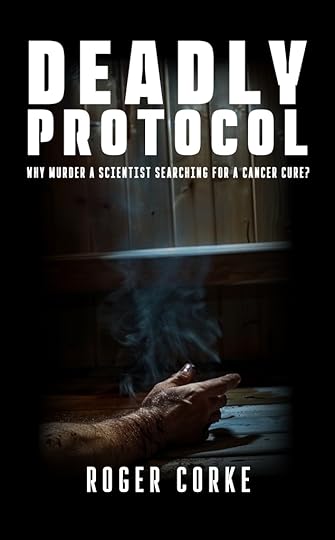
Deadly Protocol is my debut novel and is the ultimate medical conspiracy. A scientist working in London on the Holy Grail of medicine – a universal cure for cancer – is found brutally murdered: who killed him and why? So far, no one has been able to answer both of those questions before they’re revealed in the book.
Dr Veronica Ackerman – who must solve the murder mystery after she wakes up in the victim’s bed, following a disastrous one-night stand, – discovers his body downstairs. He has been bludgeoned to death and is roasting on the heater in his sauna, which is the inspiration for the stunning cover.
The stakes turn out to be higher – far higher – than Ronnie could ever have imagined, as she is pursued across the world by the killers before coming back to Britain in a bid to trap the mastermind behind the plot.
Buy Link:
You can order Deadly Protocol from Amazon by clicking onto amzn.to/3yQtriF
Amazon eBook: https://amzn.to/3z4uj38
You can order it from Diamond Books at bit.ly/3Mt1Mr9
Deadly Protocol is published by specialist crime publishers Diamond Books.
If you’d like to know more about Roger and his book, please check out his social media links below:
You can find Roger Corke’s Facebook author page at: https://www.facebook.com/profile.php?id=61563973661953
September 5, 2024
Guest Post: Behind the Scenes of The Pirate’s Physician by Amy Maroney
Today is publication day for The Pirate’s Physician by my good friend and fellow historical fiction author, Amy Maroney. Amy has kindly written a guest post in which she tells us about the inspiration behind her main characters.
I usually focus on women artists of the medieval and Renaissance era in my fiction, but when I discovered the trailblazing woman physician Trotula of Salerno, I made an exception.
In my research, I had come across many female midwives and healers, but not one physician. And yet Trotula de Ruggiero (also known as Trota of Salerno and Dame Trot), a graduate of the Schola Medica Salernitana in Salerno, Italy, was a renowned physician in her day. Not only did she practice medicine, she also published treatises about women’s health that circulated widely in Europe long after her death.
I decided to honor Trotula’s memory with a character in my Sea and Stone Chronicles series, which is set in the medieval Mediterranean. Like Trotula, my character Guiliana Rinaldi studied at Salerno’s famed medical school. In my novels, Guiliana makes several small but critical appearances, doling out medical care and advice to the women of Rhodes, Greece.
But I could hear Guiliana whispering in my ear after the series of three novels was completed. “Minor character, eh?” she’d say. “You don’t think I deserve a tale of my own?” At the same time, a certain Basque pirate whose ship appeared in those books developed the habit of perching on my other shoulder. “You didn’t even give me a name in those novels,” he’d chide me. “You’re not done with me, not by a long shot.”
After a few months of this, I capitulated. The temptation to write a love story starring Guiliana and an enigmatic Basque pirate was just too strong to ignore. The result is The Pirate’s Physician, a seafaring tale that’s a heady combination of romance, swashbuckling, and intrigue. The story gives Guiliana and her pirate—whose name turns out to be Eneko—their moment in the spotlight. And it was tremendous fun to write.
To give you a better idea of the real history behind the story, I’ll circle back to Trotula first. Then I’ll share the jaw-dropping historical tidbit that gave me permission to write about Basque pirates. And I’ll conclude with a glimpse of life on medieval merchant galleys.
Down the history rabbit hole we go!
Trotula of Salerno
Born into a wealthy 11th or 12th century family of Salerno, Trotula received a high level of education. She is said to have married a fellow physician and their sons may have practiced medicine, too. She was respected by her peers in Salerno and frequently sought after for advice.
A 13th century document called De mulierum passionibus describes an ill woman calling upon Trotula “as if she were a master of this craft.” It goes on to recount Trotula taking the woman into her home for an examination and refuting the previous diagnosis of hernia. She then cures the woman of her actual illness with baths and other treatments.
Digging around for Trotula lore, I found wonderful snippets of her writings. From her Book on the Conditions of Women: “Women, from the condition of their fragility, out of shame and embarrassment do not dare reveal their anguish over their diseases (which happen in such a private place) to a physician. Therefore, their misfortune, which ought to be pitied, and especially the influence of a certain woman stirring my heart, have impelled me to give a clear explanation regarding their diseases in caring for their health.”
Much of the information I discovered about Trotula came from the invaluable website Academia.edu, and I am particularly indebted to scholar Monica H. Green, who has conducted extensive work on the subject.
A Basque pirate straight out of history
I’ve long been fascinated by Basque culture. My first historical mystery series was set in and around Basque country in the Pyrenees mountains. I write magazine articles about the area, and I recently completed a walking tour in Spain’s Basque hills with my husband.
All this to say, I’ve known for years that the Basques have a long, illustrious history as sailors and shipbuilders. They started whaling and codfishing throughout the Atlantic Ocean in the early medieval era, and they developed a reputation as the best boat builders of Europe.
But when I researched my Sea and Stone Chronicles series in 2020, I discovered a startling line in a research paper about piracy in the Eastern Mediterranean.
According to legal records from the city of Famagusta in Cyprus during the fifteenth century, Catalan pirates used the city as a base for their operations. In protest, citizens of Famagusta made legal complaints against the city for allowing pirates to circulate freely there. One man complained that sometimes more than a hundred pirates from the Bay of Biscay (off the coast of Spain’s Basque country) would appear in the city streets. The ships they used were Atlantic whaling vessels called balenas.
This stunned me because I’d assumed the Basques just kept to themselves in the Atlantic Ocean. In fact, they were also seeking their fortunes in the Eastern Mediterranean.
I’m grateful to Nicholas Coureas and Andreas G. Orphanides for sharing this and many other details of life in the medieval Mediterranean.
So now you know the history inspiring my heroine, Guiliana, and my hero, Eneko. But what about all the seafaring and swashbuckling scenes in The Pirate’s Physician? Did I just make that up?
Life aboard a medieval galley
It turns out another one of my history obsessions is the maritime world. I’m fascinated by port cities of Europe’s Mediterranean, and I’ve done lots of research into this topic. One of my favorite sources is a research article by Benjamin Arbel about life aboard wooden galleys during pilgrims’ voyages from Venice to the Holy Land (Jerusalem).
These voyages were not for the faint of heart. Passengers struggled to sleep crammed into berths that crawled with fleas, lice, gnats, and worms. Live animals were penned on board, both as food for passengers and as working animals being transported to new homes. People often brought their own snacks to supplement what they were served aboard, including fresh fruit, lentils, and cheese. Nothing happened on these ships without the blare of trumpets and fifes (pipes) to accompany it. Passengers brought lots of musical instruments to pass the time, and special occasions such as feast days were marked with fireworks, dancing, singing, and lots of wine.
Putting it all together
When I combined these details of daily life with my findings on Trotula of Salerno and the Basque pirates of the Eastern Mediterranean, I had more than enough fabulous fodder for my novella. The Pirate’s Physician is steeped in real history, but it took a lot of imagination to bring this romantic seafaring adventure to life.
Where to buy the book: https://mybook.to/PiratesPhysician
Publication Date: September 5, 2024
Publisher: Artelan Press
Blurb:When her world shatters, she dares to trust a pirate. Will she survive what comes next?
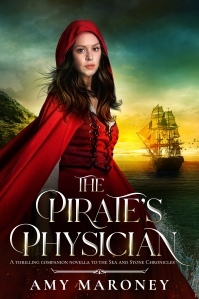
The Pirate’s Physician is the story of Guiliana Rinaldi, a student at Salerno’s famed medieval medical school, whose lifelong dream of becoming a physician crumbles when her uncle and mentor dies suddenly.
Faced with an unwanted marriage to a ruthless merchant, Guiliana enlists the help of a Basque pirate and flees home for the dangers of the open sea.
Will she make it to Genoa, where her only remaining relative awaits? Or will this impulsive decision seal her own doom?
A delightful seafaring adventure packed with romance and intrigue, The Pirate’s Physician is a companion novella to the award-winning Sea and Stone Chronicles series of historical novels by Amy Maroney: Island of Gold, Sea of Shadows, and The Queen’s Scribe.
 Author Bio:
Author Bio:

Amy Maroney lives in the Pacific Northwest with her family, and spent many years as a writer and editor of nonfiction before turning her hand to historical fiction. Amy is the author of the Miramonde Series, a trilogy about a Renaissance-era female artist and the modern-day scholar on her trail. Amy’s new series, Sea and Stone Chronicles, features strong, talented women seeking their fortunes in the medieval Mediterranean. To receive a free prequel novella to the Miramonde Series, join Amy Maroney’s readers’ group at http://www.amymaroney.com.
Author Links:
Website: https://www.amymaroney.com/
Twitter: https://x.com/wilaroney
Facebook: https://www.facebook.com/amymaroneyauthor/
Instagram: https://www.instagram.com/amymaroneywrites/
Threads: https://www.threads.net/@amymaroneywrites
Pinterest: https://www.pinterest.com/amyloveshistory/
Book Bub: https://www.bookbub.com/authors/amy-maroney
Amazon Author Page: https://www.amazon.com/stores/Amy-Maroney/author/B01LYHPXEO
Goodreads: https://www.goodreads.com/author/show/15831603.Amy_Maroney
August 29, 2024
Guest Post: Dealing with Stroppy Royals by Judith Arnopp
Those of you who have read my books will know that I tend to write about historical characters that we have come to regard as flawed, some might say ‘evil.’ Our twenty-first century sensibilities are outraged by actions which were perfectly within the bounds of acceptability at the time. Margaret Beaufort is the prime example of a woman whose historical record is spotless yet is commonly regarded as an obsessive mother with a cruel vindictive streak. One TV series even has her murder a man whom history records as dying in his own bed on a day when Margaret was many miles away. This type of character assassination is often dismissed with the words, ‘It’s only fiction,’ but as historical writers, fiction or otherwise, I feel there should be some authorial regard for the reputation of their subject.
Other than what I’d read in popular fiction, I knew very little about Margaret when I began writing The Beaufort Chronicle and my research revealed a very different woman to the one I’d expected. In book one, The Beaufort Bride, she is a child, married at a very tender age to Edmund Tudor. She is quickly widowed and gives birth to a son when she is still only around thirteen years of age. We throw up our hands in horror at this now, and there were murmurs against it at the time. Margaret herself, however, seems to have held no resentment toward Edmund. Even though the birth was traumatic and possibly ended her fertility, after two further husbands, she still requested to be buried with Edmund – a request that was denied.

Margaret deftly negotiated the war of the roses and the political upheaval that followed, managing to stay in favour with the Yorkist king Edward IV and his queen, Elizabeth Woodville. She worked tirelessly for the return of her exiled son, Henry Tudor, but it is not until the reign of Richard III that she began to manoeuvre him into the position to take the throne. Above all, Margaret was pious, loyal and generous, so given the current appreciation for strong women, our perception of her is surprising. Margaret was way ahead of her time when it comes to female rights; she certainly didn’t remain a victim for very long. The Beaufort Chronicle is a trilogy, written in Margaret’s voice, recording the events from her own perspective. She is sometimes blind to her own failings, as we all are.
When I completed the final book, The King’s Mother, I had come to know Margaret very well, or at least I’d come to know the woman who emerged from six years of research. History only provides us with facts that were recorded, as a historical fiction author I have to fill in the gaps and come up with a credible voice, and follow their path that was written long ago.
I am often asked how I manage to get inside my character’s head and convince the reader that they are listening to a historical voice. It is quite easy really. After I’ve studied the recorded facts, I sit down in an imaginary place, a tavern, or a garden for instance, and question my protagonist. How did that feel? Why did you do that? What were you thinking? What were you afraid of? Of course, fiction is only speculation. Any author, either of fiction or non-fiction, can only hypothesise about past events. None of us have been there.
After I’d finished The Beaufort Chronicle I became a little obsessed with tricky characters and wrote The Heretic Wind, which tells the life of Mary Tudor, better known as Bloody Mary. The list of atrocities she is accused of are damning; it is not until you consider her life as a whole and understand the events from her perspective that one begins to understand.

Aside from her traumatic upbringing, the religious upheaval she lived through had a pronounced effect on the passionately devout girl. We look on her today as fanatical and ruthless yet the historical record also speaks of her generosity, her compassion. Her actions against what she perceived to be heresy was bred of a deep love for her subjects. As far as Mary was concerned, the new religion would condemn her subjects to Hell. Hellfire has become a bit of a joke to many of us today yet in Mary’s time it was very real. God, Heaven and Hell, the devil, were all very real to Mary.
She had no concept of free thought. Her drastic measures were intended to deter her people from entering a pact with the devil. To us, the Smithfield Fires were abominable yet to Mary it was a last-ditch attempt to redeem her subjects from eternal punishment.
Noone can deny that Mary was wronged in childhood, deprived of love in her youth, and made miserable in womanhood. In The Heretic Wind, Mary is on her death bed when she narrates the story of her often miserable, seldom merry life. She is brutally honest, accepting her own failures, admitting her misdeeds but as she had been throughout her life, she is desperate for the approval of the listener/reader.
Once The Heretic Wind was complete, I walked away from the fires of Smithfield and turned my attention to the greatest perceived monster of them all, Mary’s father, King Henry VIII.
I will not pretend that writing The Henrician Chronicle was easy. It took four years to complete the trilogy and during that time, almost every day, Henry was in my head. It all got a little too real. Even when I put aside the laptop, he followed me into the shower, sat on my bed in the middle of the night. Sometimes he teased me, sometimes he flattered me and quite often he terrified me. Of all the characters I have written, Henry is the most complex; he was conflicted, frustrated and desperate to be loved. Blind, of course, to the misery he inflicted on others, at the end he was furious that fate had dealt him such a bad hand. By book three, his rage and hopelessness consumed both of us.
On a daily basis on social media I see Henry labelled a wife-killer, a philanderer, a monster. Nobody ever stops to ask what made him so, why he took the actions he did, what moulded him into the man he became? He is rarely judged from the standards of his day but from the obscure view of the modern world. Of course, I don’t approve of his actions or applaud him as a man or king but I try to understand him.

As I unpeeled the layers of negativity and uncovered the boy prince beneath, I discovered a likeable young man. He was fun loving, friendly, exuberant, and overflowing with good intentions, but as he led me through his life, I saw his hopes, his dreams, his grand plans for England shatter, one by one.
Henry craved the return of chivalry, a second Agincourt, he wanted to be remembered for glory, he dreamed of being a second Henry V. He also wanted to fill the royal nursery with miniature Tudors, boys in his own image. He didn’t like to fail, nobody does, and Henry had the power and the means to fight back, and fight back he did. He was nothing if not persistent. He fought for a son, he fought to regain territories lost in France, he fought against what he considered to be corruption in the church. He did not give up the fight until the very end.
In the final book, A Matter of Time, the young prince we encountered in book one, A Matter of Conscience, is vanquished, the determined king of book two, A Matter of Faith, is laid low by pain and disease. He looks back at his life and realises he has failed to achieve even one of his goals. He is a failed husband, a bad father and an underachieving king. The only thing he has gained is notoriety.
Once the last book in The Henrician Chronicle was complete, I found myself at a loss. For several months Henry lingered in the corner of my mind, tainting my joy, refusing to go away but eventually he left. Almost immediately, another door opened and out stepped my current protagonist. Marguerite of Anjou – detested French queen of Henry VI, labelled a she-wolf, brought down by York, her son disinherited, her battles lost, her status diminished. She fought hard for her son, just as Margaret Beaufort fought for hers, but whereas Margaret won glory, Marguerite lost.
She ended her days a penniless pensioner of the French king, forgotten and alone. The popular perception of her is negative yet her actions were no worse than her male contemporaries; the only difference is her sex. Marguerite’s story is one of injustice, misogyny and treason, and I don’t think the war of the roses has been told from her perspective before.
So, after spending years at the court of Henry VIII, I am once more up to my neck in the war of the roses, encountering my old friends: Edward IV, Henry Tudor, Richard III, Anne Neville, and Margaret Beaufort. I hope to see you there.
Judith Arnopp – Author Biography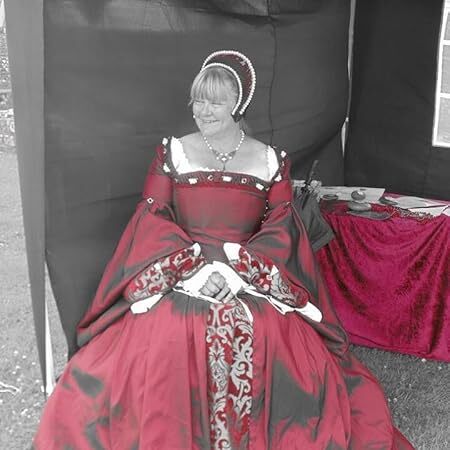
A lifelong history enthusiast and avid reader, Judith holds a BA in English/Creative writing and an MA in Medieval Studies. She lives on the coast of West Wales where she writes both fiction and non-fiction. She is best known for her novels set in the Medieval and Tudor period, focussing on the perspective of historical women and of course, from the perspective of Henry VIII himself.
Her novels include:
A Song of Sixpence: the story of Elizabeth of YorkThe Beaufort Chronicle: the life of Lady Margaret Beaufort (three book series)A Matter of Conscience: Henry VIII, the Aragon Years (Book One of The Henrician Chronicle)A Matter of Faith: Henry VIII, the Days of the Phoenix (Book Two of The Henrician Chronicle)A Matter of Time: Henry VIII, the Dying of the Light (Book Three of The Henrician Chronicle)The Kiss of the Concubine: a story of Anne BoleynThe Winchester Goose: at the court of Henry VIIIIntractable Heart: the story of Katheryn ParrSisters of Arden: on the Pilgrimage of GraceThe Heretic Wind: the life of Mary Tudor, Queen of EnglandPeaceweaverThe Forest DwellersThe Song of HeleddThe Book of ThornholdA Daughter of Warwick: the story of Anne Neville, Queen of Richard IIIMarguerite: Hell Hath No Fury (Coming soon)You can find Judith on most social media platforms.
Webpage: www.judithmarnopp.com
Books: author.to/juditharnoppbooks



